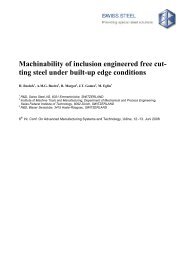Application of Thermodynamic Model for Inclusion Control in ...
Application of Thermodynamic Model for Inclusion Control in ...
Application of Thermodynamic Model for Inclusion Control in ...
You also want an ePaper? Increase the reach of your titles
YUMPU automatically turns print PDFs into web optimized ePapers that Google loves.
Process Metallurgy – Steelmak<strong>in</strong>g<br />
<strong>Application</strong> <strong>of</strong> <strong>Thermodynamic</strong> <strong>Model</strong> <strong>for</strong> <strong>Inclusion</strong> <strong>Control</strong> <strong>in</strong> Steelmak<strong>in</strong>g to<br />
Improve the Mach<strong>in</strong>ability <strong>of</strong> Low Carbon Free Cutt<strong>in</strong>g Steels<br />
Xiaob<strong>in</strong>g Zhang 1)2) , Hans Roel<strong>of</strong>s 3) , Stephan Lemgen 4) , Uli Urlau 3) , S.V.Subramanian 2)<br />
1) currently with Technology Centre, Shanghai No.1 Iron & Steel Co., Baosteel, Shanghai, Ch<strong>in</strong>a and <strong>for</strong>merly at the time <strong>of</strong> this research with<br />
2) Department <strong>of</strong> Materials Science and Eng<strong>in</strong>eer<strong>in</strong>g, McMaster University, Hamilton, Ontario, Canada<br />
3) Research and Development Department, von Moos Stahl, Emmenbrücke, Switzerland<br />
4) Production Manager, von Moos Stahl, Emmenbrücke, Switzerland .<br />
Oxide <strong>in</strong>clusions <strong>for</strong>med dur<strong>in</strong>g steelmak<strong>in</strong>g processes <strong>in</strong>fluence the mach<strong>in</strong>ability <strong>of</strong> steel products. At moderate and high cutt<strong>in</strong>g speeds,<br />
the tool life is dom<strong>in</strong>ated by chemical wear. However this wear can be suppressed by eng<strong>in</strong>eer<strong>in</strong>g exogenous and <strong>in</strong>digenous glassy oxide<br />
<strong>in</strong>clusions <strong>in</strong> steel. The present work demonstrates a method to eng<strong>in</strong>eer glassy oxide <strong>in</strong>clusions <strong>in</strong> a low carbon free cutt<strong>in</strong>g steel apply<strong>in</strong>g<br />
a new thermodynamic model <strong>for</strong> deoxidation control <strong>of</strong> steel based on slag-melt as well as melt-oxide <strong>in</strong>clusion equilibration. The model is<br />
used onl<strong>in</strong>e <strong>in</strong> an <strong>in</strong>dustrial production l<strong>in</strong>e <strong>for</strong> the controlled production <strong>of</strong> glassy <strong>in</strong>clusions. These <strong>in</strong>clusions are shown to improve mach<strong>in</strong>ability<br />
by lubricat<strong>in</strong>g the tool-chip <strong>in</strong>terface dur<strong>in</strong>g mach<strong>in</strong><strong>in</strong>g <strong>of</strong> the steel at high cutt<strong>in</strong>g speeds. Us<strong>in</strong>g an <strong>in</strong>clusion eng<strong>in</strong>eered work piece,<br />
the crater wear <strong>of</strong> an uncoated P10 tool is significantly improved and the tool life is tripled at cutt<strong>in</strong>g speeds <strong>in</strong> the range between 200 and<br />
400 m/m<strong>in</strong>. The <strong>in</strong>dustrial results show that thermodynamic modell<strong>in</strong>g is a powerful tool to produce free cutt<strong>in</strong>g steels with consistently good<br />
mach<strong>in</strong>ability behaviour.<br />
Keywords: thermodynamic model, <strong>in</strong>clusion eng<strong>in</strong>eer<strong>in</strong>g, free cutt<strong>in</strong>g steel, mach<strong>in</strong>ability<br />
Introduction<br />
The dom<strong>in</strong>ant mechanism <strong>of</strong> tool wear changes from<br />
physical wear at low cutt<strong>in</strong>g speeds to chemical wear at<br />
high cutt<strong>in</strong>g speeds. At moderate and higher cutt<strong>in</strong>g speeds<br />
us<strong>in</strong>g cemented carbide <strong>in</strong>serts <strong>in</strong> CNC mach<strong>in</strong>es, chemical<br />
tool wear tends to be a significant problem. Figure 1 shows<br />
a SEM picture <strong>of</strong> tool wear exhibited by a cemented tungsten<br />
carbide tool after cutt<strong>in</strong>g AISI 12L14 steel <strong>for</strong> 15 m<strong>in</strong><br />
at a cutt<strong>in</strong>g speed <strong>of</strong> 200 m/m<strong>in</strong>. The observed crater wear<br />
is caused by chemical dissolution <strong>of</strong> the tool material <strong>in</strong>to<br />
the chip due to high temperature at the tool-chip <strong>in</strong>terface<br />
and high diffusivity paths associated with local shear<strong>in</strong>g result<strong>in</strong>g<br />
from seizure (atomic contact) at the tool-chip <strong>in</strong>terface<br />
[1]. The depth pr<strong>of</strong>ile <strong>of</strong> crater wear is related to the<br />
cutt<strong>in</strong>g speed. When <strong>in</strong>creas<strong>in</strong>g the cutt<strong>in</strong>g speed, the crater<br />
gets deeper and moves closer to the cutt<strong>in</strong>g edge <strong>of</strong> the tool.<br />
Once the cutt<strong>in</strong>g edge is damaged, the surface quality <strong>of</strong> the<br />
work piece gets worse. Previous <strong>in</strong>vestigations show that<br />
neither lead nor manganese sulfide <strong>in</strong>clusions are effective<br />
<strong>in</strong> suppress<strong>in</strong>g crater wear [2]. However, crater wear can be<br />
Figure 1. SEM picture <strong>of</strong> WC tool exhibit<strong>in</strong>g pronounced chemical<br />
crater wear after cutt<strong>in</strong>g AISI 12L14 steel <strong>for</strong> 15 m<strong>in</strong> at a cutt<strong>in</strong>g<br />
speed <strong>of</strong> 200 m/m<strong>in</strong>.<br />
substantially reduced by eng<strong>in</strong>eer<strong>in</strong>g glassy oxide <strong>in</strong>clusions<br />
<strong>in</strong> the work piece [3]. The glassy oxide <strong>in</strong>clusions lubricate<br />
the tool-chip <strong>in</strong>terface dur<strong>in</strong>g mach<strong>in</strong><strong>in</strong>g by <strong>for</strong>m<strong>in</strong>g<br />
a viscous layer <strong>in</strong>-situ at the tool-chip <strong>in</strong>terface. The promotion<br />
<strong>of</strong> slid<strong>in</strong>g tribological conditions by <strong>in</strong>-situ lubrication<br />
at the tool-chip <strong>in</strong>terface suppresses the dissolution<br />
crater wear, which is a key to improve the mach<strong>in</strong>ability <strong>of</strong><br />
steels at moderate and higher cutt<strong>in</strong>g speeds<br />
In low carbon free cutt<strong>in</strong>g steels (LCFCS) the total oxygen<br />
content is typically ~100 ppm. At room temperature the<br />
oxygen is completely tied up as oxides <strong>in</strong> deoxidation products<br />
which are either hard and crystall<strong>in</strong>e structures or viscous<br />
glasses. The behaviour <strong>of</strong> this very small amount <strong>of</strong> <strong>in</strong>clusions<br />
dur<strong>in</strong>g mach<strong>in</strong><strong>in</strong>g is not negligible and varies from<br />
caus<strong>in</strong>g the harmful effect <strong>of</strong> abrasive wear to the beneficial<br />
effect <strong>of</strong> lubricat<strong>in</strong>g the tool-chip <strong>in</strong>terface [4,5]. Glassy oxide<br />
<strong>in</strong>clusions eng<strong>in</strong>eered <strong>in</strong>to steel <strong>in</strong> steelmak<strong>in</strong>g <strong>in</strong>-situ<br />
<strong>for</strong>m a viscous layer at the tool-chip <strong>in</strong>terface dur<strong>in</strong>g mach<strong>in</strong><strong>in</strong>g<br />
<strong>of</strong> the steel with<strong>in</strong> a certa<strong>in</strong> temperature range correspond<strong>in</strong>g<br />
to a certa<strong>in</strong> cutt<strong>in</strong>g speed range. It is the metallurgist’s<br />
challenge to eng<strong>in</strong>eer the best type <strong>of</strong> oxide <strong>in</strong>clusions<br />
<strong>in</strong>to the work piece steel <strong>for</strong> self-lubricat<strong>in</strong>g the toolchip<br />
<strong>in</strong>terface dur<strong>in</strong>g mach<strong>in</strong><strong>in</strong>g.<br />
Based on viscosity databases <strong>of</strong> oxides (at metal cutt<strong>in</strong>g<br />
temperatures and pressures) the target glassy oxide <strong>in</strong>clusions<br />
to provide slid<strong>in</strong>g tribology at the tool-chip <strong>in</strong>terface<br />
can be identified. The goal <strong>of</strong> the present work was to design<br />
a controlled deoxidation process, slag-melt equilibration<br />
and melt-oxide <strong>in</strong>clusion equilibration <strong>in</strong> steel mak<strong>in</strong>g<br />
to obta<strong>in</strong> the desirable glassy oxide <strong>in</strong>clusions. Consider<strong>in</strong>g<br />
LCFCS similar approaches have been followed focus<strong>in</strong>g on<br />
exogenous <strong>in</strong>clusions (<strong>for</strong>m<strong>in</strong>g <strong>in</strong> the melt by deoxidation)<br />
but ignor<strong>in</strong>g the design <strong>of</strong> <strong>in</strong>digenous <strong>in</strong>clusions (<strong>for</strong>m<strong>in</strong>g<br />
dur<strong>in</strong>g solidification as deoxidation products from the dissolved<br />
oxygen) [6,7]. However typically 25–50% <strong>of</strong> the total<br />
oxygen <strong>in</strong> LCFCS is present as <strong>in</strong>digenous <strong>in</strong>clusions. In<br />
314 steel research <strong>in</strong>t. 75 (2004) No. 5










